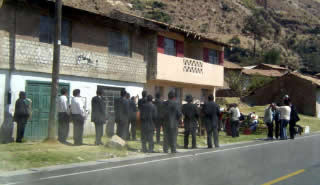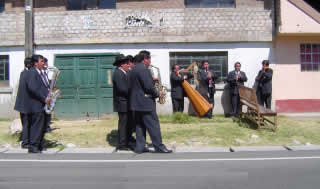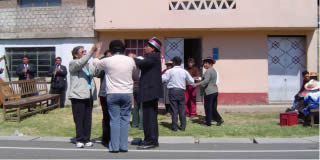The DANCES And VALLEY DANCES Of the MANTARO
They are many and varied the dances and dances that practice in the department of Junin, generally these dances and dances they are made by the unions of craftsmen, such as the sombrereros, the tailors, the carpenters, etc. Among them they emphasize the "black", "pachahuara", the "tiril", "huaylas", the "gang", and other but who serious length to enumerate, etc.
 DANCES And DANCES Of the VALLEY Of the MANTARO
DANCES And DANCES Of the VALLEY Of the MANTARO
 DANCES And DANCES Of the VALLEY Of the MANTARO
DANCES And DANCES Of the VALLEY Of the MANTARO
 DANCES And DANCES Of the VALLEY Of the MANTARO
DANCES And DANCES Of the VALLEY Of the MANTARO
DANCES And DANCES Of the VALLEY Of the MANTARO
LA CHONGUINADA
She is one of the attractive dances but by the elegance of his clothes, colorful and recamado of gold and silver. The name of this dance, that it imitates to the group and minue but ending in huayno, seems to derive from Chongos, one of its centers of greater fame. The men take generally a mask of fine mesh of wire, that characterizes to a sonrosado face of blue eyes. Its musica, ceremonious, is executed by a tipica orchestra huanca.
EL CORTAMONTES
They are the concurred celebrations but. The padrinos, named the previous year, are procured high you hoist and Las Madrinas are in charge "to dress them" (to adorn them) the sabados ones at night, with bottles of licor, fruits, shoes, serpentines, articles to dress and some aye corral. This task becomes to the compass of huaynitos orchestrated by tipicas bands contracted specially. To the following day the guests dance around arbol carrying an axe. The padrinos invite to drink licor and to taste sandwiches until arbol (the mount) falls to earth, moment in which the children and adults avalanzan themselves to take the gifts that prendian of arbol. These celebrations occur during the carnivals and but the characteristics are made in Ataura, Muquiyauyo, Frame (Jauja), Hualhuas (Huancayo) and Chupaca.
LA MULIZA
It is a followed song of dance and constitutes but the fine expression of the mountain feeling. Their verses say of the espiritualidad of the Andean soul, inspired by their landscapes and the enchantment of their women. "the muliza" name has origenes old. One says that its noticeable rate I am inspired by caminarde recuas of mules who took mineral shipments; what it is known with certainty is that this related one with the musica of the celebration of "Santiago" or of the bearing of the cattle.
LA TUNANTADA
It is the main dance of the celebrations of the 20 of eenero in Jauja, dedicated to the patterns San Sebastian and San Fabian (Christian sincretismo of the gentlemen of the thunderclap and rain). The "tunantes" represent the different social classes from the colony, asi like a the numerous visitors who venian from distant earth to cure themselves in the benign jaujino climate; for that reason, each personage of the dance takes different atuendos. The main figures are "esp?ol" and huanca "(or" the chupaquina"), their lover, always interpreted ostentosa chola by disguised men of women (because no aceptaria jaujina was known that to represent this paper); "the jaujina", elegant dressed shining jewels; the "Bolivian tucumanos", the "healers", the "cuzque?os", the "chutos", etc. The attention center is "huatrila", that when dancing enjoys making fun of worldwide, until of the present authorities.
LOS AVELINOS
In the town of San Jeronimo it is danced, each 30 of September (supervisory celebration), the dance of the "avelinos", personages who represent the guerrillas of the caceristas troops. They use one chewed of deer leather and its clothes consists of fine terno on which they superpose another one, ragged and full of patches; they wear ojotas covered of enough wool and some carry blankets, with which they goad in the seat of the town.
EL HUAYLARSH
A very well-known and spread dance of the valley (and that has undergone many modifications when leaving its rural context to become espectaculo) is "huaylarsh" or "huaylas". Its remote origin is beats it nocturnal of grains (wheat, barley), after the harvest, from alli comes the strong caracteristico zapateo. The word "huaylarsh" designates so much to the musica as to the same activity, although this less and less practices due to the flood mecanizacionde the agricolas tasks. The dance, in that they take part jovenes of both sexes, represents the showy gallantry of the male the female of the "chihuaco" or zorzal, bird that abounds in this region.
CHINCHILPOS Y GAMONALES
The district of Huayucachi conserves this strange dance where the "chinchilpos" represent the poor men and the "gamonales" to wealthy people. Coreografia represents one violent fight latigazos to define the superiority of some of both, and for that reason they wear special clothes.
Web site created on march 30 of 2005.
© Copyright 2005 Gualberto Valderrama C.
|